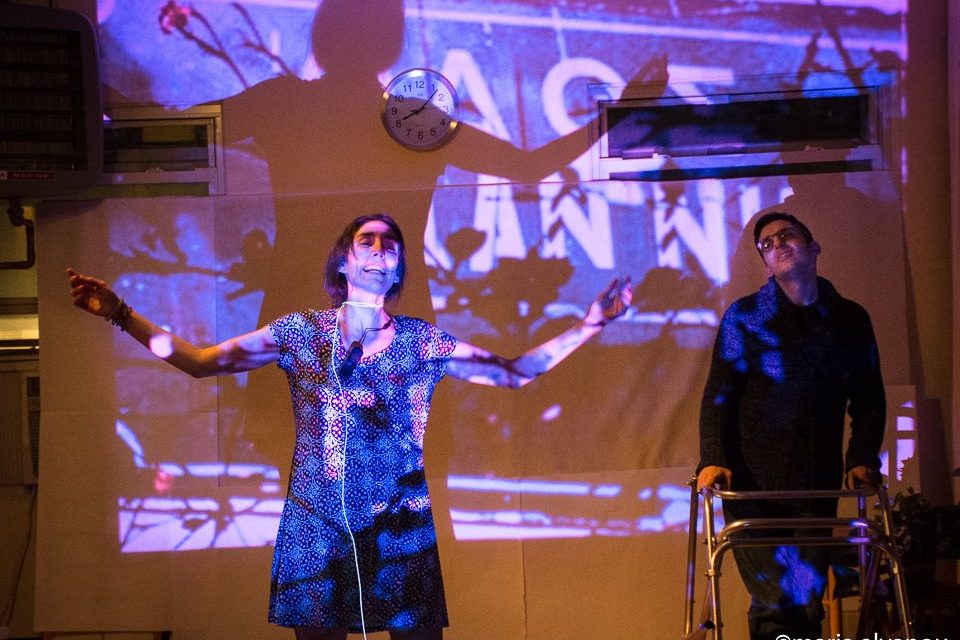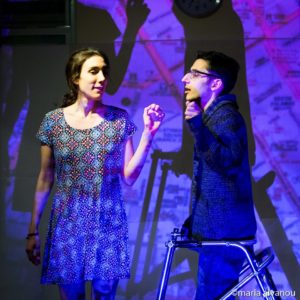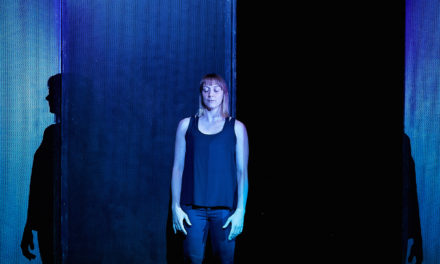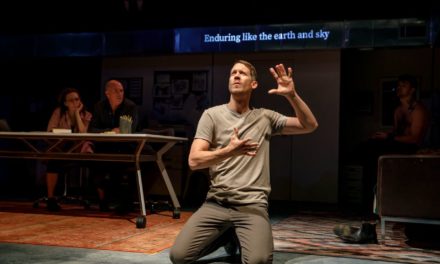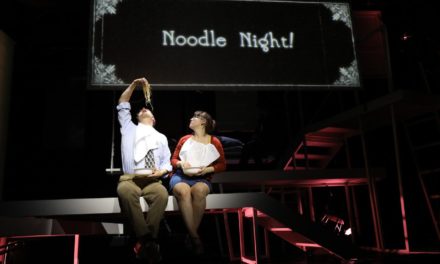When I tell people that I do theatre with actors who have neuromuscular disorders, their outward response is positive, but they typically wonder how it’s possible that someone with severe physical limitations can act.
How is it not possible?
At its core, acting is doing, and thus, an actor is someone who does something. Therefore, we are all actors because we are always doing something; every minute of our lives is filled with reactions which in turn affect the next minute we encounter, and so on.
Even so, there is a striking difference between professional and amateur actors: intense training. Professional actors study methods—usually adhering to a select few—have an exercise regime to warm up their bodies and voices, and constantly pick up new skills while improving old ones. This intense training may follow a talent for acting, but I believe that talent is simply hard work and training, which is something anyone—neuromuscular disease or not—can accomplish if they’re passionate about it.
I decided to put this theory to the test in 2012 with a group called MDA Hellas, a charitable organization that strives to improve the quality of life of people who have neuromuscular disorders. I knew that I needed to bring theatre in some way to this group, but I had to find ways to create a stylized plan for this group to be able to study, train, rehearse, and stage a performance, which involved a lot of transforming and inventing.
Out of this plan came a theatre group, ARTimeleia (the Greek word for “whole and healthy”) and while we also incorporate actors without disabilities, our ultimate goal was to utilize theatre in an ancient political sense—the Greek term which means “being part of a city,” that city being undivided, inclusive, rightful, and free. In a perfect world, everyone should be able to subscribe to these ideals, but reality doesn’t always allow it for everyone, another reason why this initiative is needed.
Our first show was Do You Not?, based on Max Aub’s Exemplar Murders, and took place in a psychiatric unit, in which all the criminals describe their murder achievements over their weekly formal dinner. Following this was An Attempt on the Apopeires, which combined movement and acting with video art. Long Roads is a story of a woman on the run in Athens who is desperately trying to find someone; this performance calls only for certain parts of the body of all involved to be shown. I Touch You is based on stories that members of the group wrote following a playwriting workshop, while last year’s performance, Fragile, the Myth of Atreidon, was the combination of myth and group-written material.
To understand how this can be done, the basic premises of the umbrella term, neuromuscular disorders, must be applied. While many of these disorders are present at birth, some manifest in childhood or even adulthood. Always rare, they are typically genetically inherited through parents with the recessive gene and effect either all muscles, motor nerves in the arms, legs, neck, and face, places where the nerves and muscles meet, or the muscle-controlling nerve cells in the spinal cord. Symptoms usually get worse over time, as muscle weaken, and while this isn’t painful in cause stiffness and cramping, joint deformities, chronic pain, and the tightening and eventual freezing of joints into a certain position (contractures).
The common myth that people who are physically disabled must also be cognitively or mentally impaired is simply not true, but some diseases under the neuromuscular umbrella have side effects that impair cognitive processes. While this stereotype also contributes to the myth that people with physical disabilities cannot be talked to in a normal way—strangers may talk to whoever that person is with instead of the person or talk slower or louder than they normally would—this is far from the truth. Those with neuromuscular diseases can do everything any other person can do, like study, work, become Olympic gold medal winners, love, change the world (i.e. Stephen Hawking), and even act—they just might need to be a little more creative in order to achieve their goals.
Creativity is key when it comes to MDA Hellas’ theatre group, as there are certain body parts that some actors cannot use and some that they can. Each person is different, but in order to have a common ground, a few “tactics” are imposed. First, all the actors must understand that the point of all their efforts is to tell a story, rather than be “good” at acting. In order to do so, the use of eyes to show expression and create dynamic mood shifts are an important tool that all of the theatre group members can utilize. In fact, there are numerous tools that even nondisabled actors have at their fingertips, and while it may not seem like that tool can’t be used to act, it is not until it is thought of in the context of acting that it is deemed useful.
In addition, there is a lot of time spent on training and exercise. Breathing exercises are essential for acting purposes and to keep the weaker respiratory systems of these specific actors as strong as possible, while muscle stretching is utilized to help test physical limits, and adapted acting exercises are used to keeps the actors on their toes (figuratively). A large chunk of time is spent on building up learning-memory patterns in terms of sensory and emotional recall. While certain actions may not be able to occur on stage, it has been proven that imagining an action or experience stimulates the same part of the brain that “lights up” when that experience is actually occurring. Therefore, when an actor with a neuromuscular disease imagines him or herself walking on stage, the brain sees it as same as if he or she was actually walking.
In this way, audiences should see no difference between an actor with a disability or an actor without one.
When I first began integrating nondisabled actors into the group, I had an experience that only further reiterated the fact that individuals with disabilities need to be a part of our theatrical reality. Following the closing performance of Fragile, the Myth of Atreidon, one actress with a neuromuscular disease called Spinal Muscular Atrophy expressed her thanks for being given a chance to work with the non-disabled actors. In her own words: “I am grateful for working with you because I know now that you can also lose your balance, fall, forget your lines, and make mistakes. Thank you for reminding me that I am like you.”
As a theatre group, MDA Hellas avoid plays that clearly state that a particular role cannot be performed by an actor with a physical disability, yet I’ve never come across a play that emphasises this. So why do you?
Annita Capousizi works as a teacher and program director of theater at MDA HELLAS (Muscular Dystrophy Association). She is in the United States as a Fulbright Artist Scholar, developing her neurological research on acting.
Edited by Maddie Parrotta
This post was written by the author in their personal capacity.The opinions expressed in this article are the author’s own and do not reflect the view of The Theatre Times, their staff or collaborators.
This post was written by Annita Capousizi.
The views expressed here belong to the author and do not necessarily reflect our views and opinions.

